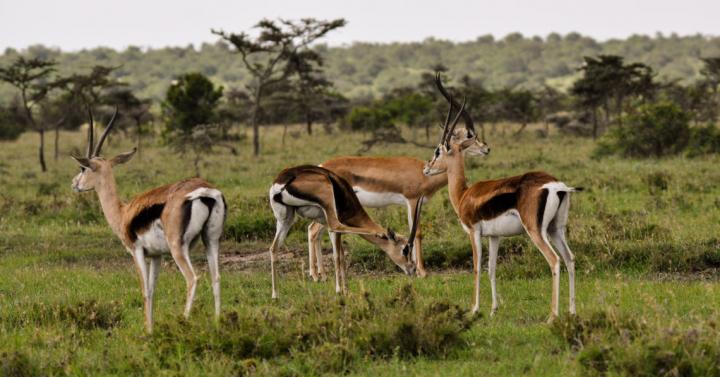
Credit: Ria Ghai
Animals living in large groups tend to have more parasites than less social animals do, but according to a new study in Proceedings of the Royal Society B, they may also be better protected from the negative effects of those parasites.
Ecologists at the University of Georgia found that Grant’s gazelles that live in larger groups were more likely to be infected by intestinal worms, but less likely to suffer their ill effects than those in smaller groups.
“The phenomenon of getting intestinal worm parasites is common to many, many species,” said Vanessa Ezenwa, a professor in the Odum School of Ecology and College of Veterinary Medicine. “And one of the strongest negative impacts of these types of infections, well described in domesticated animals, is that they cause anorexia. We find that in this wild species, being social somehow counteracts that effect.”
Ezenwa conducted the study in Mpala Research Center in Kenya. Using nets deployed from a helicopter, her team captured wild gazelles. After tagging each one, they collected fecal samples and noted each animal’s size, weight and other statistics. They treated half of the gazelles with a deworming drug that was effective for 120 days; the other half were left untreated as a control. The researchers then followed all of the animals for over a year, collecting fecal samples to monitor parasite levels and recording observations on the animals’ social and feeding behavior.
They found that gazelles in larger groups–groups of up to 25 individuals, with an average size of nine–had a 39 percent higher risk of infection than those living in smaller groups.
But infected animals in these larger groups ate significantly more than infected animals in smaller groups–almost as much as uninfected animals.
Ezenwa said that one reason the infected animals in larger groups may eat more is that the larger group offers more protection from predators.
“There’s a hypothesis called ‘many eyes,'” she said. “When the group is bigger, the rate of detection of predators goes up, because at any given time there are more individuals paying attention. So that can free up individuals to put more time into other behaviors, and typically that would be feeding.”
Ezenwa says that an important next step would be to conduct experiments under controlled conditions to explore the physiological and behavioral mechanisms driving the effect she observed.
Ezenwa also cautioned that the phenomenon of social living reducing the cost of infection may not be applicable to all parasites.
“What I’m describing here might be particularly relevant for very common parasites you can’t avoid over the course of your lifetime, but for rarer ones it might be a different story,” she said. “If you’re going to be infected no matter what, like with these worms where the prevalence is really high and there’s no way to protect yourself from them, then being in a big group might be an important way to minimize the impact of infection.”
Ezenwa said that the results of the study show that it’s important to think about both costs and benefits when trying to understand how social interactions shape infectious disease outcomes in individuals and populations.
“We are a social species just like these gazelles,” said Ezenwa. “Being social has a lot of implications for our health. We already know that social contact has a huge impact on our exposure to infectious diseases, so I think what we need to understand better is how social contact might simultaneously give us advantages in terms of reducing the impacts of those infectious diseases.”
###
The study, “Social living simultaneously increases infection risk and decreases the cost of infection,” which is available online at http://rspb.
Media Contact
Vanessa Ezenwa
[email protected]
706-542-2288
Original Source
https:/




